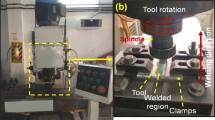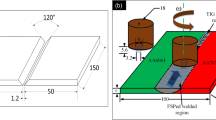Abstract
Stationary shoulder friction stir welding has been used to weld 4-mm-thick 2219-T6 aluminium alloy at high rotation speeds. Strain plastic damage was applied to demonstrate the formation mechanism of welding defects at high rotation speeds above 2000 rpm. A three-way converging zone in the joint, in which materials of different microstructure characteristics converged from three directions during high tool rotation speed welding, was found. At the relatively high tool rotation speed, the significant differences in the microstructures would result in weld defects in this zone. It could be attributed to material toughness damage at high strain rate. With increasing tool rotation speed, the tensile strength of the joint constantly decreased. When the tool rotation speed varied from 2000 to 2600 rpm, the tensile strength decreased from 305 MPa (68.2% of the BM) to 238 MPa (53.2% of the BM).











Similar content being viewed by others

References
Mishra RS, Ma ZY (2005) Friction stir welding and processing [J]. Mater Sci Eng R Rep 50(1-2):1–7
Thomas WM, Nicholas ED (1997) Friction stir welding for the transportation industries. Mater Des 18(4-6):269–273
Davies PS, Wynne BP, Rainforth WM (2011) Development of microstructure and crystallographic texture during stationary shoulder friction stir welding of Ti-6Al-4V[J]. Metall Mater Trans A 42(8):2278–2289
Maltin CA, Nolton LJ, Scott JL (2014) The potential adaptation of stationary shoulder friction stir welding technology to steel. Mater Des 64:614–624
Ji S, Meng X, Ma L (2015) Vertical compensation friction stir welding assisted by external stationary shoulder [J]. Mater Des 68:72–79
Cho JH, Kim WJ, Lee CG (2014) Texture and microstructure evolution and mechanical properties during friction stir welding of extruded aluminum billets. Mater Sci Eng A 597(597):314–323
Sun T, Roy MJ, Strong D (2017) Comparison of residual stress distributions in conventional and stationary shoulder high-strength aluminum alloy friction stir welds [J]. J Mater Process Technol 242:92–100
Martin J P (2013) Stationary shoulder friction stir welding/Proceedings of the 1st International Joint Symposium on Joining and Welding. Woodhead Publishing, pp 477–482
Wu H, Chen YC, Strong D (2015) Stationary shoulder FSW for joining high strength aluminum alloys. J Mater Process Technol 221:187–196
Sun T, Tremsin AS, Roy MJ (2018) Investigation of residual stress distribution and texture evolution in AA7050 stationary shoulder friction stir welded joints. Mater Sci Eng A 12:531–538
Li JQ, Liu HJ (2013) Effects of tool rotation speed on microstructures and mechanical properties of AA2219-T6 welded by the external non-rotational shoulder assisted friction stir welding. Mater Des 43:299–306
Li D, Yang X, Cui L (2014) Effect of welding parameters on microstructure and mechanical properties of AA6061-T6 butt welded joints by stationary shoulder friction stir welding. Mater Des 64:251–260
Hosain MM (2004) Development of high speed friction stir welding machine. Wichita State University
McNelley TR, Swaminathan S, Su JQ (2008) Recrystallization mechanisms during friction stir welding/processing of aluminum alloys. Scr Mater 58(5):349–354,064
Li B, Shen Y, Hu W (2011) The study on defects in aluminum 2219-T6 thick butt friction stir welds with the application of multiple non-destructive testing methods. Mater Des 32(4):2073–2084
Hu Y, Liu H, Fujii H (2019) Improving the mechanical properties of 2219-T6 aluminum alloy joints by ultrasonic vibrations during friction stir welding. J Mater Process Technol
Hu Y, Liu H, Li S (2018) Improving mechanical properties of a joint through tilt probe penetrating friction stir welding. Mater Sci Eng A 731:107–118
Gazder AA, Dalla Torre F, Gu CF (2006) Microstructure and texture evolution of bcc and FCC metals subjected to equal channel angular extrusion. Mater Sci Eng A415(1-2):126–139
Cao GKS (2005) Friction stir welding of 2219 aluminum: behavior of θ (Al2Cu) particles. Weld J 84(1):S1
Frigaard Ø, Grong Ø, Midling OT (2001) A process model for friction stir welding of age hardening aluminum alloys [J]. Metall Mater Trans A 32(5):1189–1200
Nielsen KL, Pardoen T, Tvergaard V (2010) Modelling of plastic flow localisation and damage development in friction stir welded 6005A aluminum alloy using physics based strain hardening law. Int J Solids Struct 47(18-19):2359–2370
Li D, Yang X, Cui L (2015) Investigation of stationary shoulder friction stir welding of aluminum alloy 7075-T651. J Mater Process Technol 222:391–398
Balmforth NJ, Frigaard IA, Ovarlez G (2014) Yielding to stress: recent developments in viscoplastic fluid mechanics. Annu Rev Fluid Mech 46:121–146
Goods SH, Brown LM (1979) Overview no. 1: the nucleation of cavities by plastic deformation. Acta Metall 27(1):1–15
Argon AS, Im J, Safoglu R (1975) Cavity formation from inclusions in ductile fracture. Metall Trans A 6(4):825
Song M, Kovacevic R (2003) Thermal modeling of friction stir welding in a moving coordinate system and its validation. Int J Mach Tools Manuf 43(6):605–615
Liu XC, Sun YF, Nagira T (2019) Strain rate dependent micro-texture evolution in friction stir welding of copper. Materialia 100302
Nielsen K L, Pardoen T, Tvergaard V (2010) Modelling of plastic flow localisation and damage development in friction stir welded 6005A aluminum alloy using physics based strain hardening law
Funding
The authors are grateful to be supported by the National Key Research and Development Program of China (2018YFB1306404), by the Key areas Research and Development Program of Guangdong Province (2019B090921003), by the Province Science and Technology Plan Project of Guangdong (2015B090922011), by the Science and Technology Plan Project of Guangzhou City (201807010063 and 201807010068) and by the National Natural Science Foundation of China (51905112).
Author information
Authors and Affiliations
Corresponding authors
Additional information
Publisher’s note
Springer Nature remains neutral with regard to jurisdictional claims in published maps and institutional affiliations.
Rights and permissions
About this article
Cite this article
You, J., Zhao, Y., Dong, C. et al. Microstructure characteristics and mechanical properties of stationary shoulder friction stir welded 2219-T6 aluminium alloy at high rotation speeds. Int J Adv Manuf Technol 108, 987–996 (2020). https://doi.org/10.1007/s00170-019-04594-1
Received:
Accepted:
Published:
Issue Date:
DOI: https://doi.org/10.1007/s00170-019-04594-1



